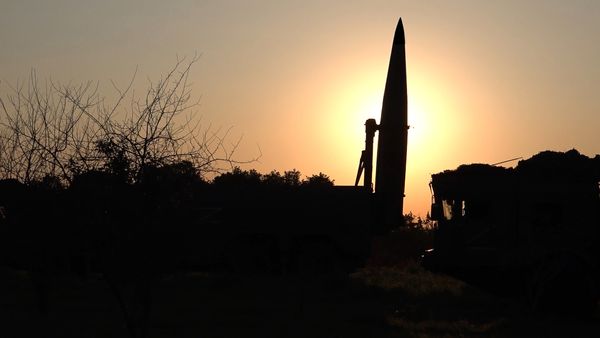
Proposals to revive commercially viable large-scale nuclear energy are farcical in the extreme, but what’s behind recent talk of a nuclear “renaissance”? It arose in the late 1990s and early 2000s, driven by concerns about the need to reduce reliance on fossil fuels, decarbonise the electrical grid, and respond to an ageing nuclear fleet due for decommissioning.
Nuclear was claimed to be the only “reliable” alternative to fossil fuels, a coded way to reproduce as much as possible of the political-economic and technical incumbency effects connected to the centralised generation of electricity.
As we’ve been told, nuclear power — being low-carbon in operation mode — would be necessary to decarbonise. So the main problem with selling new nuclear as necessary is that it is no longer, well, necessary.
Non-hydro renewables have overtaken nuclear power, with wind and solar alone reaching 10.2% of global gross power generation in 2021, the International Renewable Energy Agency (IRENA) says. Investment in non-hydro renewable electricity capacity is now 15 times that of reported global investment decisions for nuclear construction.
The GenCost 2022 report by Australia’s Commonwealth Scientific and Industrial Research Organisation (CSIRO), in conjunction with the Australian Energy Market Operator (AEMO), found renewables vastly cheaper than nuclear even after factoring in integration costs such as storage and transmission.
The distinctly non-radical BP Statistical Review of World Energy from 2022 confirms that picture of the nuclear v renewables debate. The share of all-renewables (excluding hydropower) in global power generation reached 13% in 2021. In 2019-21, non-hydro renewables’ share of power generation grew more than the combined total of coal and natural gas, and in 2015-21, non-hydro renewables generation accounted for 60% of the growth in global power generation.
The 2021 BP Statistical Review of World Energy showed that nuclear power’s share of global electricity generation had started declining as early as 1999. And in that year, the percentage share of natural gas “crossed over” nuclear power’s share, replacing it, while nuclear continued to decline, being replaced again by the upward swing of non-hydro renewables in about 2020.
But is nuclear power there when you need it, as renaissance rhetoric suggests? The short answer is no. That’s also the long answer.
Nuclear advocates fetishise baseload and availability. The pin-up celebrity for baseload is France, with a fleet of 56 reactors supplying 70% of its electricity. But as gas shortages hit Europe in 2022 after Russia’s invasion of Ukraine, the Électricité de France (EDF) fleet suffered an annus horribilis. More than half the fleet was shut down for repairs and maintenance due to cracking and corrosion issues, resulting in record unplanned outages and nuclear output at a 30-year low.
Or consider the Japanese nuclear fleet post-Fukushima. Gross electricity generation dropped from 275 TWh in 2011 to about 50 TWh as of July 2022. As the World Nuclear Industry Status reports have documented in the past decade, the IAEA has misrepresented the health of the Japanese fleet, routinely listing reactors in long-term outage (LTO) as “operational”.
Of the IAEA’s listed “33 operating reactors” reactors for 2022, only 10 are operating and 23 are in LTO. Neither reliable nor resilient, nuclear power is often not there when you need it.
What about the proposition that a “boutique” nuclear fleet can be built quickly to fill the energy gap? Construction times for reactors completed in the 1970s and ’80s were homogenous — about four to eight and a half years on average. But since 1990, this has started to vary widely, bordering on limited predictability: six to 10 years on average through the ’90s before exploding post-2000 into a six- to 20-year free-for-all. In 2019-21, the mean construction time for reactors connected to the grid was just over eight years.
“Generation III+” reactor projects have all experienced cost and construction blowouts. Prime examples are: Olkiluoto-3 in Finland (expected 2009, became 2023, costs quadrupled); Flamanville-3 in France (expected 2012, still building, costs up fivefold); Vogtle 3 and 4 in the United States (expected 2016-17, still building, costs up fivefold).
The nuclear power industry is forgetting by doing — a negative not positive learning curve.
Can nuclear power change? Advocates pin their hopes on small modular reactors (SMRs), defined as sub-300MWe reactors designed for serial construction or as sub-15MWe reactors designed for remote uses. They are being sold with the same style of utopian rhetorical visions seen decades ago in the industry development stage, only now as risk-free, as environmental saviours, and even as vehicles for Indigenous autonomy.
The reality is less glowing (or more). As documented by independent energy analysts at the IEEFA, the NuScale SMR-plant proposal offered to the US state of Utah has already seen a reduction in units and a 53% jump in costs that render it even less cost-competitive with renewables than its originally uncompetitive offer.
In fact, the visions of the proponents of SMRs might also have the effect of reversing or stalling decarbonisation.
Consider a 2021 University of Queensland study of what would be required for SMRs to be operating in Australia from the 2030s, which suggested SMRs could be sited on disused coal plants and be integrated into the existing electricity infrastructure. The study breezily concluded deployment of SMRs “would not require additional large investments in transmission and storage”.
Nuclear lobbyists then used this study in August 2022 Senate hearings on the Climate Change Bill (emissions reductions) to argue against grid upgrades. Nuclear was presented as a cheaper option for decarbonising the grid because “if we particularly use suitably-sized nuclear power plants on our grid, we do not need to expand the grid”.
Since every AEMO projection suggests that grid upgrades are essential to achieve greater penetration of renewables into the national electricity market, the SMR push represents a “crowding-out process”. Countries with greater attachment to nuclear will tend to have lesser attachment to renewables and vice versa.
Any talk of SMRs should be interrogated for signs of material commitments, such as opposing grid upgrades, that mitigate against renewables.
Any new push for nuclear will involve a massive waste of resources, decades of false paths, and take the process of creating a green energy system backwards. Less tragedy then farce, than farce followed by more farce.
This is an edited extract from the essay “Nuclear Afterlife” from “Set It On Fire With Your Love”, a special issue of Arena Quarterly on nuclear power, technocracy and catastrophe, available now.






